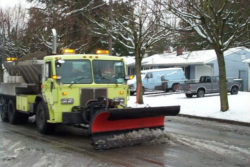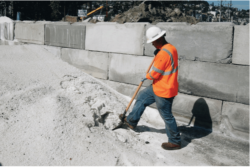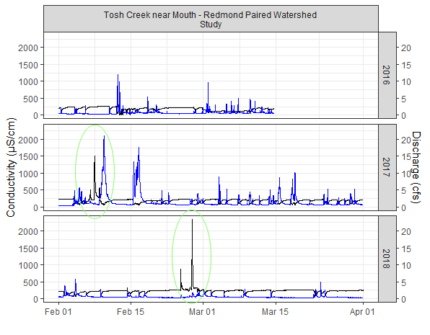by Tim Clark, King County
adapted from the King County Streams Monitor, a monthly newsletter about stream water quality and hydrology in King County
 As the Puget Sound region prepared for the “snowmageddon” of February 2019, stores were emptied of snow shovels and salt. Deicers, like road salt and certain chemicals, allow for safer travel and continued emergency vehicle access. Road salt came into widespread use in the 1960s, and today more than 22 million tons are applied to U.S. roadways each year.
As the Puget Sound region prepared for the “snowmageddon” of February 2019, stores were emptied of snow shovels and salt. Deicers, like road salt and certain chemicals, allow for safer travel and continued emergency vehicle access. Road salt came into widespread use in the 1960s, and today more than 22 million tons are applied to U.S. roadways each year.
Unfortunately, there is a salty side to this story: a growing body of research indicates that many of the nation’s streams, lakes, and rivers are getting saltier. A recent study found that a third of 232 U.S. streams and rivers monitored by the U.S. Geological Survey have gotten saltier in the last century. The authors called this Freshwater Salinization Syndrome. Road salt is a dominant source of salinization of fresh water in colder, humid regions of the midwestern and eastern United States, and has contributed to long-term, increasing trends in sodium and chloride in surface water and ground water. Another recent study found that 44% of 371 freshwater lakes studies have undergone long-term salinization.
Increased levels of chloride can harm aquatic organisms by interfering with osmoregulation, the biological process by which they maintain the proper concentration of salt and other dissolved matter in their bodily fluids. High chloride may directly or indirectly kill off sensitive species and shift the balance of aquatic ecosystems.
Cities and counties in the Puget Sound lowlands do not typically have to rely on road salts as often as municipalities in the much colder northeastern U.S., but recent events show that use is high here when the weather calls for it. For example, the City of Seattle has 35 snowplows and applied about 1,000 tons of road salt to city roads for the February 2019 snowfall. The King County Roads Division plows and salts up to 15% of its roadways. Washington State Department of Transportation maintains 500 plows and a stockpile of thousands of tons of salt and sand and millions of gallons of liquid deicer.
What is road salt?
 Road salt is distinct from table salt. While both are sodium chloride, road salt has not been purified of mineral impurities and often includes anti-caking agents. Other salts may also be used as road salt (e.g., potassium chloride, magnesium chloride).
Road salt is distinct from table salt. While both are sodium chloride, road salt has not been purified of mineral impurities and often includes anti-caking agents. Other salts may also be used as road salt (e.g., potassium chloride, magnesium chloride).
No matter the salt, road salts depress the freezing point of water – the dissolved salts make it more difficult for water to freeze into ice. Road salt is not effective at extremely low temperatures.
A 1992 study from Marquette University in Milwaukee, Wisconsin, found that road salt reduced crashes by 88%, injuries by 85%, and accident costs by 85%.
Are King County’s streams impacted by road salts?
We do not know the degree to which King County streams overall are impacted by road salts. Our long-term monitoring program is not designed to track limited duration events but rather typical conditions over time. To detect whether a stream is impacted by runoff from road salts, continuous conductance or chloride measurements would be needed to identify whether road salt application resulted in increased pulses from runoff in county streams. Some projects have included continuous conductance monitoring to meet their needs.

Continuous conductance (black line) and stream discharge (blue line) monitoring in Tosh Creek in Redmond, WA, captured road salt runoff in 2017 and 2018. There was no evidence of road salt runoff in 2016. In early February 2017, a snowfall and cool weather was well-predicted and in late February 2018, a convergence zone dumped two to three inches of snow over Redmond. Conductance spikes were seen following road salt application, but they did not last long.
Continuous conductance1 monitoring in Tosh Creek in Redmond detected pulses of conductance following well-predicted snowfalls. The application of road salts in preparation for wintry conditions in 2017 and 2018 resulted in some of those salts entering Tosh Creek. The elevated conductance did not last long, nor did it reach levels that are believed to harm aquatic organisms over such a short period.
Under normal conditions, runoff entering a stream typically has lower conductance than the groundwater below, and when runoff enters a stream, the conductance will decrease. If storm runoff is picking up applied road salts, its conductance is expected to greatly increase; these peaks were seen in Tosh Creek.
Are there alternatives to road salt?
Transportation agencies are exploring methods to decrease road salt use or use a more eco-friendly alternative. The Seattle Department of Transportation has treated roads before snowstorms by spraying brine on them, and then salting them later. “Pre-treating prevents the ice from building up, which means you have to use less salt down the road,” Ethan Bergerson of the Seattle Department of Transportation told KUOW.
Beet juice, sugarcane molasses, barley residuals from vodka production, and cheese brine, among other substances, have been mixed in to reduce the overall chloride load on the environment. When these products are used, lower levels of salt are needed. Sand and volcanic rock have also been used to provide traction and avoid toxicity.
1 Conductance is the measure of dissolved ions in water and can be used as a surrogate for chloride ions.
Related articles
Joseph Stromberg, Smithsonian – What Happens to All the Salt We Dump on the Roads?
Joshua Rapp Learn, Smithsonian – Road Salt Can Disrupt Ecosystems and Endanger Humans
USGS – Urban Stream Contamination Increasing Rapidly Due to Road Salt
King5 – Crews Monitoring Puget Sound Streams for Road Salt Contamination









